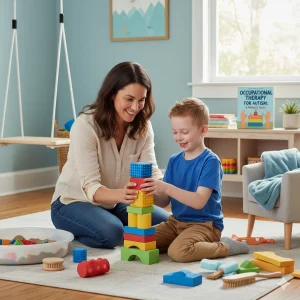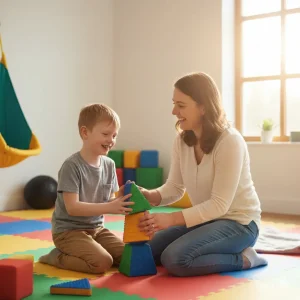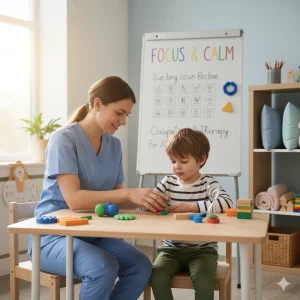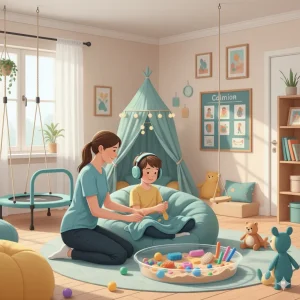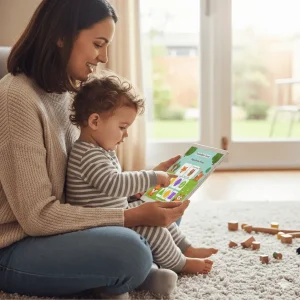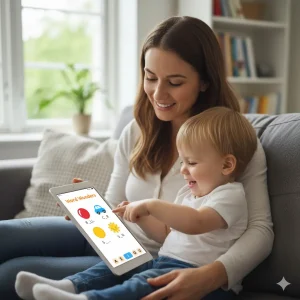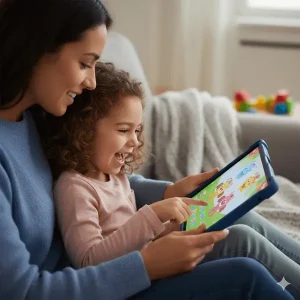How to Get the Most Out of the BASICS App: 7 Pro Tips for Parents
By Wellness Hub
Last Updated: July 23, 2025
Is your child struggling with speech, communication, or social skills? If so, you’re not alone. Whether they’ve been diagnosed with autism, speech delay, or are simply late talkers, the right tools can make a big difference in their development. That’s where the BASICS App comes in.
More than just another learning app, BASICS is a therapist-designed, story-driven tool that’s already helping over 7 lakh families across the globe. Not only is it loved by parents and professionals, but it’s also widely recognized as one of the best speech therapy apps for kids. Why? Because it combines fun, interactive adventures with structured learning to support speech, emotions, and social development in children aged 2 to 8.
1. Understand Your Child’s Needs First
Every child develops at their own pace, but as a parent, it’s natural to feel concerned when your little one isn’t meeting milestones—especially when it comes to speech, behavior, or learning. The first step to using the BASICS App effectively is to understand where your child needs support.
Some children may show signs of a speech delay—not using words as expected for their age, struggling to form sentences, or not responding when spoken to. Others may face challenges with social interaction, emotional regulation, or attention, which could indicate conditions like autism in toddlers or early signs of ADHD. Even children without any diagnosis might simply need help building vocabulary, confidence, or early academic skills.
This is where early intervention becomes so important. The earlier you identify and support a child’s communication needs, the better their chances of developing strong foundational skills. But getting started doesn’t have to mean long clinic visits or overwhelming assessments. Sometimes, all it takes is the right tools at home.
The BASICS App is designed with this understanding in mind. Whether your child has a formal diagnosis or you’re just noticing some developmental gaps, BASICS offers a structured yet playful way to help. From building first words to teaching how to express feelings, the app supports both neurodivergent and neurotypical children aged 2 to 8.
It’s a safe, guided environment where your child can grow at their own pace—and where you, as a parent, are never left guessing what to do next.
2. Choose the Right Mode: Goal Mode vs. Library Mode
One of the most powerful features of the BASICS App is that it adapts to your child’s unique learning journey. Whether you’re looking for structured therapy for children or prefer a more flexible, play-based approach, BASICS offers two easy-to-use modes: Goal Mode and Library Mode. Both are designed to help your child learn in a way that works best for them.
Goal Mode: Structured, Guided Therapy
If you’re looking for a speech therapy app with goals, Goal Mode is the ideal place to begin. Created by expert therapists, this mode follows a step-by-step learning pathway. You can choose from a wide range of developmental goals—like Learning First Words, Answering WH Questions, or even full tracks like BASICS for 2–3 Years.
Each goal is divided into Chapters and Sets. Moreover, every Chapter is wrapped in an engaging Adventure, such as “Mighty the Mammoth is Hungry” or “Rainbow Salad.” These story-based elements help keep children motivated while also ensuring steady, structured progress. As a result, Goal Mode is perfect for parents who want a clear plan with visible outcomes—especially if your child has speech delays, autism, or other developmental needs.
Library Mode: Flexible, Therapist-Friendly Exploration
On the other hand, if your child enjoys exploring independently—or if you’re a therapist guiding sessions—Library Mode offers complete flexibility. This is where child-led learning apps truly shine. You can easily access any Level, Group, or Set without following a fixed sequence.
In particular, Library Mode is useful when you want to target a specific skill, like WH questions, articulation, or social interaction. It gives kids the freedom to revisit favorite activities, which reinforces learning through repetition. Additionally, it allows you to adjust based on your child’s mood, attention span, or interest on any given day.
So, Which Mode Should You Choose?
- Choose Goal Mode if your child needs structured therapy, enjoys stories, and benefits from steady progression.
- Choose Library Mode if your child is already in therapy, prefers flexibility, or learns best through open exploration.
The best part? You can switch between both modes anytime. This way, you’re never locked into a single path. Whether your child learns best with structure or spontaneity, the BASICS App is designed to support their learning—their way.best with structure or spontaneity, the BASICS App is designed to meet them exactly where they are.
3. Set Developmental Goals That Match Your Child’s Level
Every child learns differently—and at their own pace. That’s exactly why the BASICS App offers customizable therapy goals tailored to your child’s current abilities. Whether your little one is just beginning to say their first words or is already working on building sentences, BASICS makes it easy to pick the right starting point.
Start with Simple Goals
To begin, if you’re using a speech therapy app for toddlers, the first step is to keep things simple. For very young children—or those with speech delays—the “Learning First Words” goal is the ideal place to start. It introduces basic vocabulary using clear visuals, sounds, and repetition. This goal helps children connect words with meaning in a fun and interactive way, especially for everyday categories like people, animals, foods, and body parts.
Progress to WH Questions
As your child begins to progress, you can shift to more advanced goals—like “Answering WH Questions.” This goal helps children understand and respond to questions such as what, where, who, and why. It’s particularly effective for children who find conversation or comprehension difficult. Practicing WH questions builds both language and cognitive skills, making it a vital step in early speech therapy.
A Structured System That Grows With Your Child
What sets BASICS apart is its structured, step-by-step learning system. Each goal is divided into Levels and Groups, targeting key developmental areas like vocabulary, articulation, emotions, and social interaction. For instance:
- Level 1: Matching and First Words
- Level 4: Vocabulary Expansion
- Level 7: WH Questions Practice
- Level 9: Social Stories and Emotions
This structure ensures your child doesn’t skip important milestones. Instead, they move forward in a logical sequence—one step at a time, with each level building on the last.
Therapy Meets Play
Moreover, what makes BASICS one of the best apps for speech delay is how it blends clinical expertise with engaging play. Every activity is intentionally designed by therapists—not random games. This approach supports real progress, helping your child grow through fun, focused learning sessions.
Adapt As Your Child Grows
Finally, because BASICS lets you switch or update goals at any time, the app grows with your child. You can start with naming, then shift to WH questions, and later explore social-emotional skills.
In short, whether you’re working on first words or full conversations, BASICS helps you set the right goals at the right time—turning screen time into meaningful developmental progress.
4. Use Story-Based Adventures to Keep Kids Engaged
Let’s face it—most kids don’t sit still for long. Especially if your child is on the autism spectrum or has attention difficulties, keeping them engaged in learning can be a real challenge. That’s why the BASICS App takes a playful, immersive approach through story-based therapy.
Unlike traditional worksheets or rigid apps, BASICS wraps each learning chapter inside a fun, animated Adventure. These aren’t just cute distractions—they’re part of a carefully designed system of interactive learning for kids that taps into storytelling, imagination, and motivation.
For example, in the “Mighty the Mammoth is Hungry” Adventure, your child completes therapy sets to help Mighty collect and eat fruits. Or in “Toby the T-Rex Crossing the Bridge,” the dinosaur takes a step closer to the other side with every completed task. There’s also the delightful “Rainbow Salad” where your child adds a colorful ingredient after each activity—all while learning new vocabulary. And for emotional development, “Daisy the Dodo” lets children track their feelings on a visual emotions chart.
These stories are more than just entertainment—they give purpose to each learning task. Children feel like they’re helping a character, solving a challenge, or completing a mission. This kind of narrative motivation is especially powerful in an autism app with stories, where kids often thrive on routines, characters, and visual cues.
To keep things fresh, the app allows you to rotate between Adventures or select your child’s favorite one. This helps prevent boredom and increases anticipation, especially for younger children or those who benefit from predictable patterns with variety.
Parents have shared how their children ask to “play the mammoth game” or “make the salad again,” not realizing they’re actually doing speech therapy. That’s the magic of story-driven learning—it turns skill-building into something kids look forward to.
So if you’re looking for a story-based therapy app that captures your child’s attention while still delivering meaningful progress, BASICS makes every session a little adventure—one step closer to better speech, language, and emotional growth.
5. Create a Daily Therapy Routine at Home
When it comes to helping your child grow, consistency is key. Whether your child has a speech delay, autism, or just needs extra support with early learning, a daily routine can make a huge difference. The good news? You don’t need to be a therapist to create one. With the right tools and a little structure, you can easily build a speech therapy at home routine that fits your family’s lifestyle.
The BASICS App is designed for this very purpose. As an autism therapy app for toddlers and young children, it blends professional guidance with fun, interactive content—perfect for daily use. But to get the most out of it, it’s important to create a calm, focused space and set aside a specific time for therapy.
What’s the Ideal Session Length?
Children aged 2 to 8 typically do best with short, focused sessions. Aim for:
- 10–15 minutes per session for toddlers (2–3 years)
- 20–30 minutes for older kids (4–8 years)
Start small and adjust based on your child’s attention span. You don’t need to finish an entire goal in one sitting—just completing one or two sets a day is great progress.
Create a Comfortable Setup
Find a quiet spot with minimal distractions—a play mat, a small table, or even a corner of the living room. Make sure your child can clearly see and hear the screen. Use headphones if needed, and keep their favorite comfort toy nearby if that helps them stay calm.
Mix In-App Learning with Offline Play
To keep things balanced, combine app time with hands-on activities. BASICS offers printable resources like flashcards, sentence builders, and emotion charts that can be used offline. After working on a new word in the app, practice it with real objects around the house or during play. If your child learns a new emotion word like “happy,” talk about what made them feel that way today.
This kind of home therapy routine helps children generalize what they learn in the app to everyday life.
Stay Consistent, But Keep It Positive
Try to schedule therapy around the same time each day—right after breakfast or before bedtime. Keep the tone light and encouraging. If your child resists one day, that’s okay. Celebrate small wins, like finishing one set or answering a question correctly. The goal is progress, not perfection.
With just a little planning, you can turn everyday moments into powerful learning opportunities. And with BASICS guiding the way, your child gets expert-designed support that feels more like play than work.
6. Use Parent Courses and Teaching Resources Inside the App
When it comes to helping your child grow, consistency is key. Whether your child has a speech delay, autism, or just needs extra support with early learning, a daily routine can make a huge difference. The good news is you don’t need to be a therapist to create one. With the right tools and a little structure, you can easily build a speech therapy at home routine that fits your family’s lifestyle.
To support this goal effectively, the BASICS App is designed for this very purpose. As an autism therapy app for toddlers and young children, it blends professional guidance with fun, interactive content—perfect for daily use. However, to get the most out of it, it’s important to create a calm, focused space and set aside a specific time for therapy.
What’s the Ideal Session Length?
Generally speaking, children aged 2 to 8 typically do best with short, focused sessions. As a starting point, aim for:
- 10–15 minutes per session for toddlers (2–3 years)
- 20–30 minutes for older kids (4–8 years)
Start small, and adjust based on your child’s attention span. Remember, you don’t need to finish an entire goal in one sitting—just completing one or two sets a day is great progress.
Create a Comfortable Setup
Next, find a quiet spot with minimal distractions—a play mat, a small table, or even a corner of the living room. Make sure your child can clearly see and hear the screen. Use headphones if needed, and keep their favorite comfort toy nearby if that helps them stay calm.
Mix In-App Learning with Offline Play
To keep learning dynamic, combine app time with hands-on activities. BASICS offers printable resources like flashcards, sentence builders, and emotion charts that can be used offline. For instance, after working on a new word in the app, practice it with real objects around the house or during play. If your child learns a new emotion word like “happy,” ask them about what made them feel that way today.
By doing this, you help children generalize what they learn in the app to everyday life.
Stay Consistent, But Keep It Positive
Ideally, try to schedule therapy around the same time each day—right after breakfast or before bedtime. Meanwhile, keep the tone light and encouraging. If your child resists one day, that’s okay. Instead of stressing, celebrate small wins, like finishing one set or answering a question correctly. The goal is progress, not perfection.
In the end, with just a little planning, you can turn everyday moments into powerful learning opportunities.
7. Bonus Tips for Common Challenges
Even with the best tools in hand, real-life parenting comes with real-life challenges. Whether you’re using the BASICS App as an autism app for a nonverbal child or as an app for a late talking child, you might run into bumps along the way—like screen resistance, short attention spans, or emotional overload. The good news? These hurdles are normal, and there are simple ways to work through them.
Struggling with Screen Resistance? Try Making It a Game
Some children—especially those with sensory sensitivities—may not immediately take to using a screen. If your child resists, keep sessions short and playful. Start with just 5 minutes and build up gradually. Choose their favorite character or story-based Adventure to spark interest. Sitting with them and reacting positively can also turn screen time into bonding time. For many kids, once they realize it’s not just “another app,” but a fun experience, resistance fades naturally.
Dealing with Short Attention Spans
Young children or those with ADHD or autism often have limited attention spans. Break sessions into mini-tasks. With BASICS, you don’t need to finish an entire chapter—just completing one Set per session is a win. Use visual and sound cues from the app to celebrate progress, and don’t force focus if your child is clearly overwhelmed. Learning should feel light, not stressful.
Supporting Nonverbal Children
If you’re using the app as an autism app for a nonverbal child, focus on levels that support receptive language first—like identifying objects, matching sounds, or tapping on images. The Word Wonders and Foundation Forest levels are great places to begin. Encourage pointing, tapping, or eye-gazing to build communication without pressure to speak. Over time, with consistent use, many children begin to vocalize or imitate sounds as confidence grows.
For Kids Struggling with Emotions or Social Skills
Children with autism or speech delays may find it hard to express feelings, understand social rules, or manage big emotions. That’s where tools like Emotions Explorer and Social Stories inside the app really shine. Emotions Explorer helps children recognize facial expressions and label their own feelings using visuals, which is especially helpful for those who are still learning emotional vocabulary.
Meanwhile, Social Stories teach real-life scenarios—like going to school, sharing toys, or calming down when upset—in a gentle, first-person format. These stories give children a clear model for what to expect and how to respond in everyday situations. It’s not just learning; it’s life practice in a safe, visual way.
Conclusion
The BASICS App is one of the best speech therapy and autism apps for kids, combining fun stories with expert-designed learning. It’s perfect for toddlers with speech delay or children with autism who need extra help with talking, emotions, and social skills. Use it daily for just a few minutes and watch your child grow! Stay consistent, track progress, and explore helpful parent tips inside the app. It’s a holistic app for autism and speech support—all in one place.
Frequently Asked Questions:
1. What is the BASICS App and how does it help my child?
The BASICS App is a speech therapy and autism app for children aged 2 to 8. It uses fun stories, games, and expert-designed activities to help your child learn speech, emotions, social skills, and early academics.
2. Is BASICS the best speech therapy app for kids at home?
Yes! BASICS is considered one of the best speech therapy apps for kids because it offers structured goals, playful Adventures, and support for parents—all from home.
3. Can I use the BASICS App for a late-talking child?
Absolutely. BASICS is a great app for late talking children. It helps build first words, sentence formation, and listening skills using simple, engaging visuals and stories.
4. Is the BASICS App helpful for nonverbal or autistic children?
Yes. BASICS is a trusted autism app for nonverbal children. It supports learning through pictures, matching, sound cues, and social stories to help children communicate in their own way.
5. How much time should I use the app each day?
Just 10–20 minutes a day is enough! Short, daily sessions work best. It keeps your child focused and makes therapy part of your regular routine.
6. What’s the difference between Goal Mode and Library Mode in BASICS?
Goal Mode gives a step-by-step path for learning. Library Mode lets you explore freely. Both help with structured therapy for children, depending on your child’s needs.
7. Does BASICS teach WH questions and emotions?
Yes! The app has a full section for WH questions practice (like what, where, who) and also teaches emotions through fun games and the Emotions Explorer tool.
8. Are there resources for parents in the BASICS App?
Definitely. The app has caregiver courses, flashcards, sentence builders, and emotion charts. It’s a complete parent guide for autism and speech delay support.
9. Can I use BASICS with my child even without a diagnosis?
Yes! The app is for all children who need help with speech, learning, or emotional growth—whether they have a diagnosis or not.
10. How do I start using the BASICS App with my child?
Start by downloading the app and choosing a simple goal like “Learning First Words.” Use it daily, celebrate small wins, and follow the tips inside to make learning fun and easy.
About Wellness Hub – Empowering Every Child’s Development
Wellness Hub is a trusted digital platform that empowers parents, caregivers, and professionals with science-backed tools for childhood development. From online speech therapy to home therapy resources, we offer a holistic ecosystem for children facing speech delays, autism, ADHD, and other developmental challenges.
Rooted in evidence-based practices and delivered by certified experts, Wellness Hub bridges the gap between accessibility and quality care. Whether you need at-home speech strategies, developmental checklists, or interactive mobile apps like BASICS, we make early intervention affordable and family-friendly.
Start your journey today with expert guidance tailored to your child’s unique communication and learning needs—anytime, anywhere.
Book your Free Consultation Today
Parent/Caregiver Info:
Client’s Details:
* Error Message

